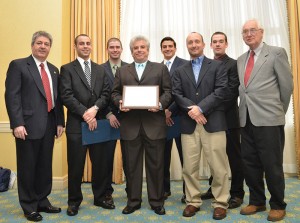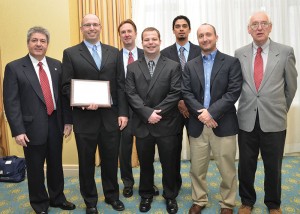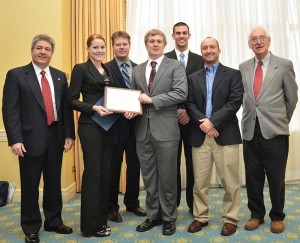Each year, the Structural Engineering Institute (SEI) gives undergraduate engineering students the opportunity to apply what they’ve learned, and showcase their engineering skills, through the annual SEI Student Competition. I want to take this opportunity to recognize the top three teams from last year’s competition and to tout this program’s many benefits.
The first place team from Villanova consisted of Stephen Kane, Scott Albarella, John Garland, Michael Mignella, and Louis Ross with Zeyn Uzman as their faculty advisor. Their project, “US Rte. 67 Corridor Project – Jerseyville Bypass Bridge Design”, addressed the design of a 140-foot long simple span, steel plate girder bridge with a composite concrete deck as part of a multibillion dollar roadway improvement project being implemented by the Illinois Department of Transportation. Their submission was impressive and displayed a professional level of effort. Calculations included deflection limits, constructability requirements, and a cost analysis to determine the optimum number of girders.
Second place went to the team from the University of Colorado, Denver, for their “Idaho Springs Maintenance Facility” project. Team members John Pettit, Jose Cordoba, Jeff Gee, Ramon Martinez, and Jeff Felling, under the direction of Faculty Advisor Peter Marxhausen, designed a 6,500 square foot maintenance building for the Idaho Springs Public Works Department. Interior space functionality, sustainability, site conditions, and surrounding architecture were all factors considered in this project that was presented to City officials.
The team from the Milwaukee School of Engineering captured third place with their project, “Sweet Water Organics Vertical Farm Design”. Team members Austin Meier, Mark Peterson, and Stephanie Pichotta, with Faculty Advisor Christopher Raebel, designed a vertical farming structure for Sweet Water Organics in Milwaukee, Wisconsin. This urban farming and aquaponics facility had very specific and unusual functional and architectural requirements that posed a unique challenge for the team.
I was struck by the high caliber of the submissions, the depth to which each team analyzed their project, and the dedication of each team member and faculty advisor to go above and beyond what is typically expected in an undergraduate engineering course. These professional level projects took the participating teams beyond classroom theories and gave them real world experience. Students who had learned about stress and strain were required to consider bigger picture concerns such as client preferences, cost effectiveness, and efficient use of interior space.
Zeyn Uzman, the Villanova team’s faculty advisor, is a full time structural engineer but teaches on the side as an adjunct professor. He requires his students to approach the Student Competition with the perspective of a practicing engineer. “I tell my students that they are no longer in school, but work under my direction as they would in an engineering firm. I explain to them that there is no partial credit. A mistake in a design can cost lives.” CU Denver’s faculty advisor, Peter Marxhausen, agrees that the competition “encourages senior-level civil engineering students to look at a large-scale infrastructure project and develop a solution that is real, comprehensive, and worthy of a peer review from SEI.” Chris Raebel, faculty advisor for the Milwaukee School of Engineering team adds, “this was a great opportunity for the students to present on a bigger stage than they are used to.”
The competitors are also required to learn important soft skills. Effective time management, teamwork, and good communication, both verbal and written, are hallmarks of successful teams. These skills translate directly into career success once the students graduate. Steve Kane from the Villanova team states, “We were able to use many of the technical skills we had learned throughout our 4 years, but also put in to practice the time management and teamwork skills we had honed through various other smaller scale projects.” Austin Meier from the Milwaukee School of Engineering team adds, “Being able to properly communicate one’s idea in a presentable and professional format is a great tool to have in one’s repertoire.”
Established in 2009, the SEI Student Competition continues to grow and attract some of the country’s best and brightest structural engineering students. It recognizes emerging talent and allows them to shine before members of their future profession at the SEI Structures Congress, where the top three teams are invited to present their projects. This competition clearly has an impact on those who participate. “Being recognized by such an important group of people at the SEI conference is the biggest honor I had” affirms José Cordoba from the University of Colorado, Denver team.
The success of the competition is largely due to the tireless efforts of Jonathan Goode, Chair of the SEI Student Initiatives Committee. Kudos to Jonathan and his committee for their devotion to the development of the structural engineering profession! Details of the SEI Student Competition, instructions on how to enter, and more information on last year’s winning projects can be found on the SEI website. If you are at the Structures 2013 Congress in Pittsburgh on May 2-4, attend the session featuring this year’s Student Competition winners for a glimpse at the future of our profession. You won’t be disappointed!▪



